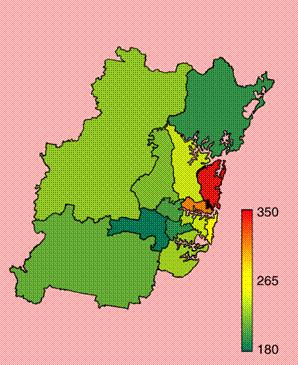|
|
Population studies
Living means consuming, and consuming causes resource depletion and environmental degradation, but also creation of jobs and income. The consumption habits of people across Australia and the world differ substantially, and so do the associated social, environmental and economic impacts.
At the University of Sydney we have carried out a number of population studies on environmental effects, such as
- the carbon footprint of the UK population, commissioned by Defra UK,
- the Australian Environmental Atlas (co-developed with the Australian Conservation Foundation),
- a comparative study of the energy requirements of the pipulations of Australia, Brazil, Denmark, India, and Japan,
- the ecological footprint of Canberra in 1999 (funded by the Australian Capital Territory's Chief Minister's Department),
- the ecological footprint of Victoria in 1999 (funded by the Victorian Department of Sustainability and Environment),
- the ecological footprint of Melbourne in 1999 (funded by the Port Phillip and Westernport Catchment Management Authority),
- the ecological footprint of Wollongong in 1999 (funded by Wollongong Council),
- the ecological footprint of Sydney and NSW in 1994 and 1999 (funded by the EPA NSW for the 2003 State-of-Environment Report),
- the ecological footprint of Far North Queensland in 1999,
- the energy requirements of Sydney in 1999,
- a comparison of energy requirements of the people of Australia, Brazil, Denmark, India and Japan (in collaboration with the Energy Planning Program at the Federal University of Rio de Janeiro, Brazil, the Institute for Economic and Industry Studies in Tokyo, Japan, and AKF Institute of Local Government Studies in Copenhagen, Denmark),
- CO2 emissions from Danish households (in collaboration with AKF Institute of Local Government Studies),
- water used by Australians in 1995 (in collaboration with the CSIRO)
- the ecological footprint and greenhouse gas emissions of Australians in 1995, and
- energy requirements and greenhouse gas emissions of Australians in 1993.
In order to visualise impacts spatially, we are at present drafting an atlas that illustrates the distribution of contributions to social and environmental impacts across the Statistical Subdivisons of the City of Sydney.
 Energy requirement (in Gigajoules) per capita for Sydney Statistical Subdivisions
Energy requirement (in Gigajoules) per capita for Sydney Statistical Subdivisions
For further information contact us for the following journal articles:
- Lenzen M, Wier M, Cohen C, Hayami H, Pachauri S, and Schaeffer R,A comparative multivariate analysis of household energy requirements in Australia, Brazil, Denmark, India and Japan, Energy 31, 181-207, 2006,
- Cohen C A M J, Lenzen M and Schaeffer R, Energy requirements of households in Brazil, Energy Policy 55, 555-562, 2003,
- Lenzen M, Dey C J and Foran B, Energy requirements of Sydney households, Ecological Economics, 49 (3), 375-399, 2004,
- Lenzen M and Murray S A, A modified ecological footprint method and its application to Australia, Ecological Economics 37 (2), 229-255, 2001,
- Lenzen M and Foran B, An input-output analysis of Australian water usage, Water Policy 3 (4), 321-340, 2001,
- Wier M, Lenzen M, Munksgaard J and Smed S, Effects of household consumption patterns on CO2 requirements, Economic Systems Research 13 (3), 259-274, 2001,
- Lenzen M, Primary energy and greenhouse gases embodied in Australian final consumption: an input-output analysis, Energy Policy 26 (6), 495-506, 1998.
For further information please contact
|
Dr Arne Geschke
ISA, School of Physics A28
The University of Sydney NSW 2006
+61 (0)2 9036-7505
[email protected]
|
|


 Energy requirement (in Gigajoules) per capita for Sydney Statistical Subdivisions
Energy requirement (in Gigajoules) per capita for Sydney Statistical Subdivisions